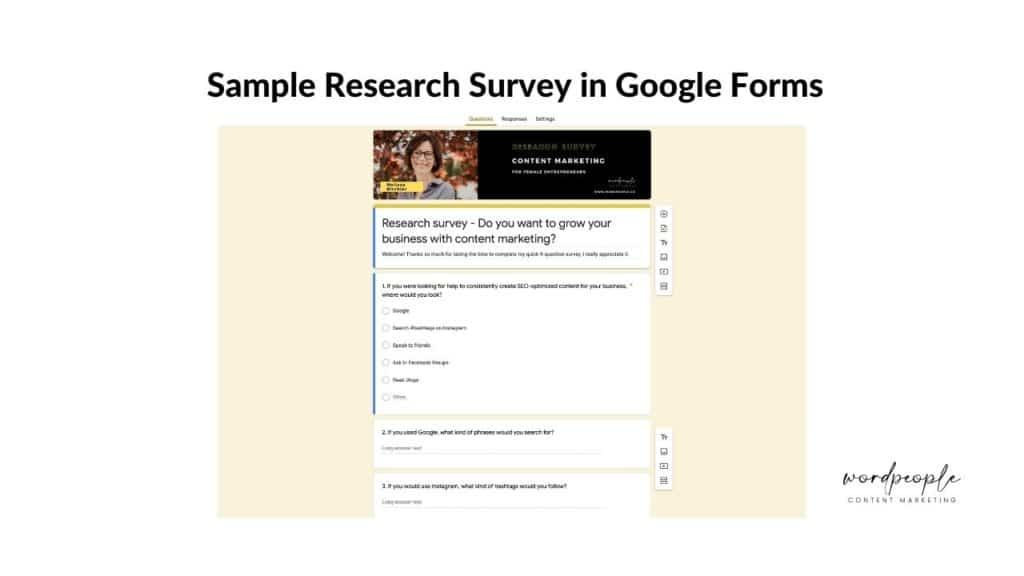This article provides seven key steps on how to create a content strategy that gets results.
Your content strategy is your master plan for creating demand using your content. It is created once and outlines how you will attract visitors to your site and encourage them to take action e.g. buy something, read something or share something. You can refer to it on a monthly and weekly basis and update it once a year. Use the following steps to quickly turn your website into a marketing machine.
Step 1: Get clear about your target client
To have success with any type of marketing, you have to know who your client is.
“Behind every tweet, share and purchase is a person, like you and me.” Michael Brenner, Marketing Insider Group
What information can you give them that will help solve their problems? When you have some clarity about their “pain points” then you can ensure that your content is always relevant, meaningful, and useful.
“The stronger the relationships that you build as a result of your content marketing strategy, the stronger your brand affinity and ultimately – your conversion rates.” Digital Marketing Institute
There are two ways to gather insights about your target clients.
- Primary research – Have a phone conversation. Ask your clients what would make their lives easier. Make it a goal to have three market research conversations per month. You can also ask in the social media forums where your clients hang out to fill out a short Google Forms Survey. I have created a short one like this as a sample. (Feel free to complete it by the way!).
- Secondary research – Use data from your Google Analytics, Google Search Console, and SEO tools. Which terms are website visitors searching for the most? Which content is the most popular? What content from your competitors drives a lot of traffic?
Here is an example of an example buyer persona template that I made for a luxury digital wedding album maker. It is useful to include the feelings around the problem to be solved. e.g. frustration, overwhelm, etc. These can then be addressed directly in your marketing copy and home page content.
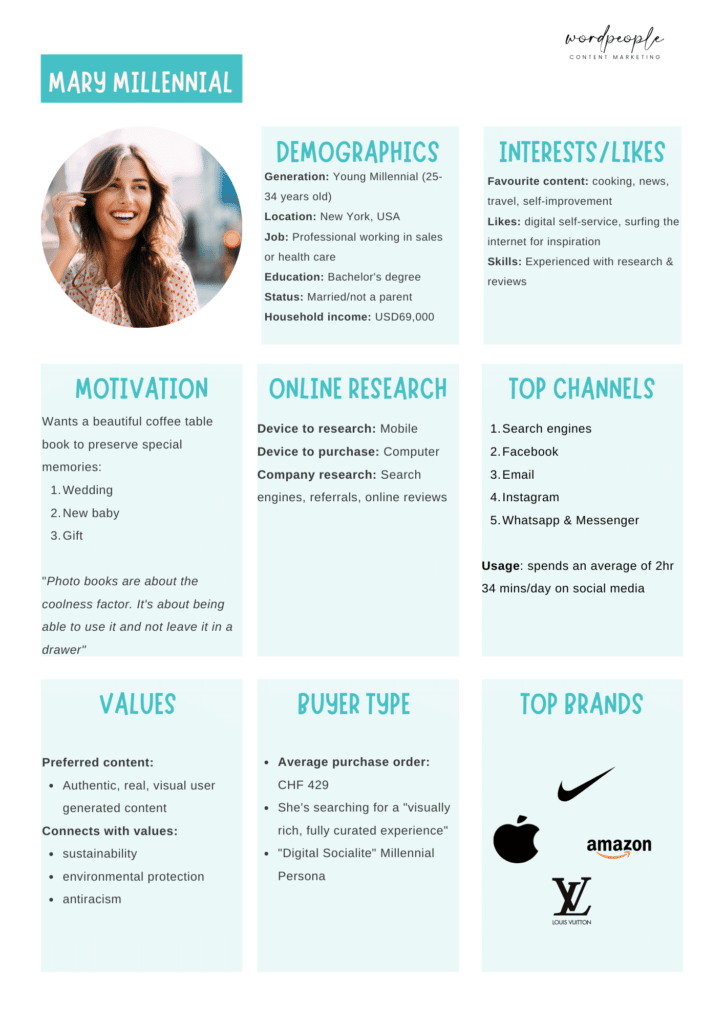
Step 2: Develop your content mission statement
An important part of a content strategy is a content mission statement. It is simply one or two sentences to keep you focused during your content creation process and prevent you from writing irrelevant content that doesn’t resonate with your target client. Write it on a sticky note and keep it somewhere on your computer.
It is the intersection between your brand’s purpose (what you know and can write about) and what customers want (topics to solve their problems). If you consistently share your expert knowledge, your ideal clients will be naturally drawn to you.
“A content mission statement is the cornerstone of your content strategy. It states what we’ll be publishing, who it’s for and why they’ll care.” Andy Crestodina at Orbit Media
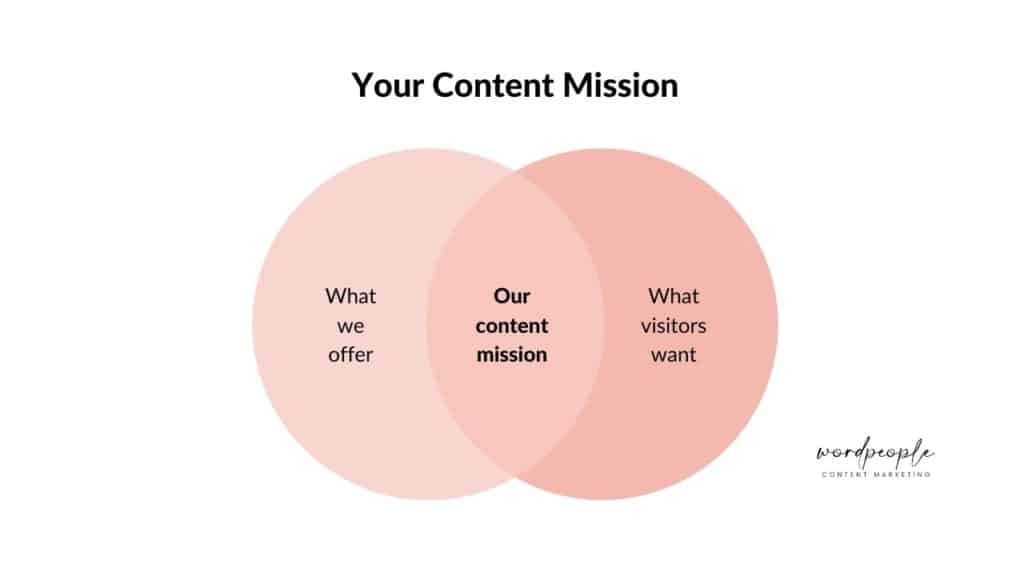
Here are some examples:
Example 1: Content Marketing Agency
We will provide female founders (audience) with a simple way to write high-quality SEO-optimized content (content product) so they can grow their businesses with ease (user need). This will help us grow our email list and attract more of our ideal clients.
Example 2: Health Coach
XYZ Health Coaching will provide women (audience) with the best nutritional advice (content product) so they can lose weight and have more energy (user need). This will help XYZ Health Coaching to increase its revenue.
Step 3: Choose your topics or content clusters
Google is placing greater emphasis on content that is in-depth and comprehensive. Creating four or five content pillars or clusters will keep you focused on what you will write about and what you exclude. It may seem restrictive, but it will ultimately save you time and “content fatigue” as you struggle to come up with ideas each month. Importantly, it will satisfy Google’s E.A.T (expertise, authority and trust) requirements and position you as an expert.
Originally developed by Hubspot, it is an SEO strategy that focuses on topics rather than keywords. Here is an example for a health coach:
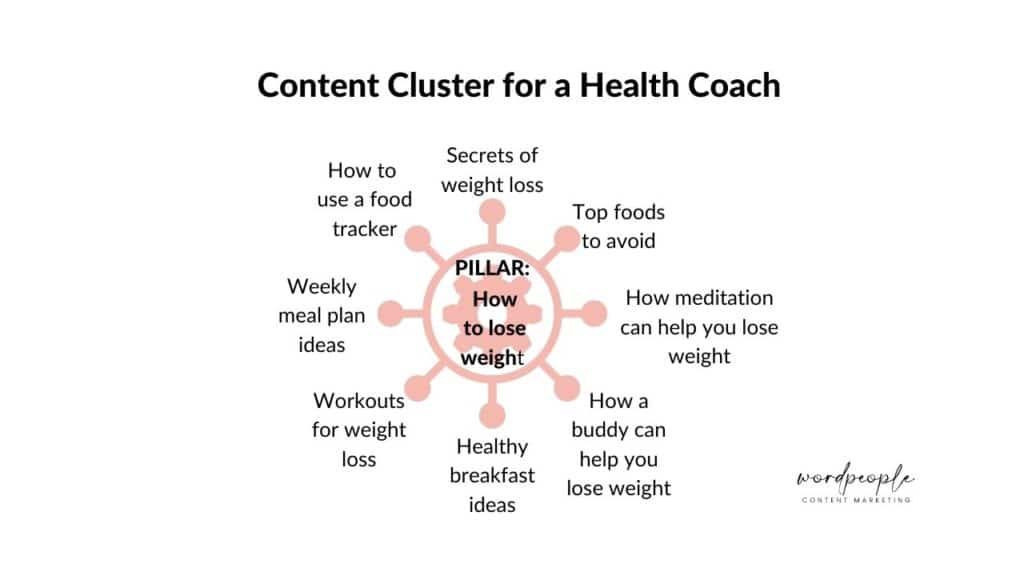
Here is another way of thinking about topic clusters:
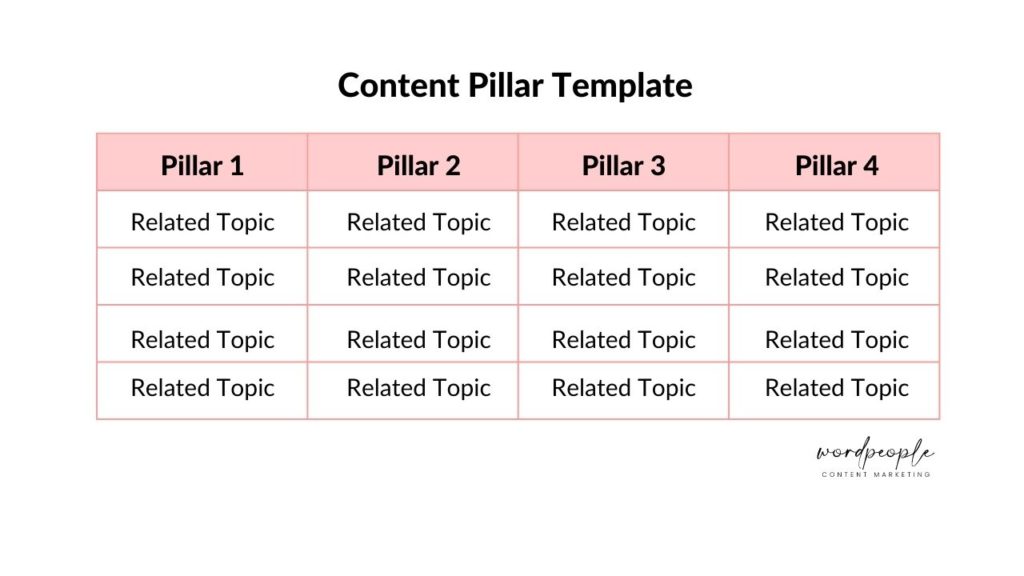 When you plan your content pillars, you need to align them with the keywords and phrases that your clients are searching for in Google.
When you plan your content pillars, you need to align them with the keywords and phrases that your clients are searching for in Google.
After establishing your content clusters or topics that interest your clients, you can map them to your client’s buying journey. This simply means identifying what content would be most useful to your clients as they move from:
- Awareness (e.g. “oh no, I am five kilos overweight”),
- Discovery there is a solution (e.g. “there are health coaches who can help me”)
- Purchase (e.g. “hiring a health coach who has what I want”).
To help your client move through the sales funnel, you can create core pieces of content like in the example below.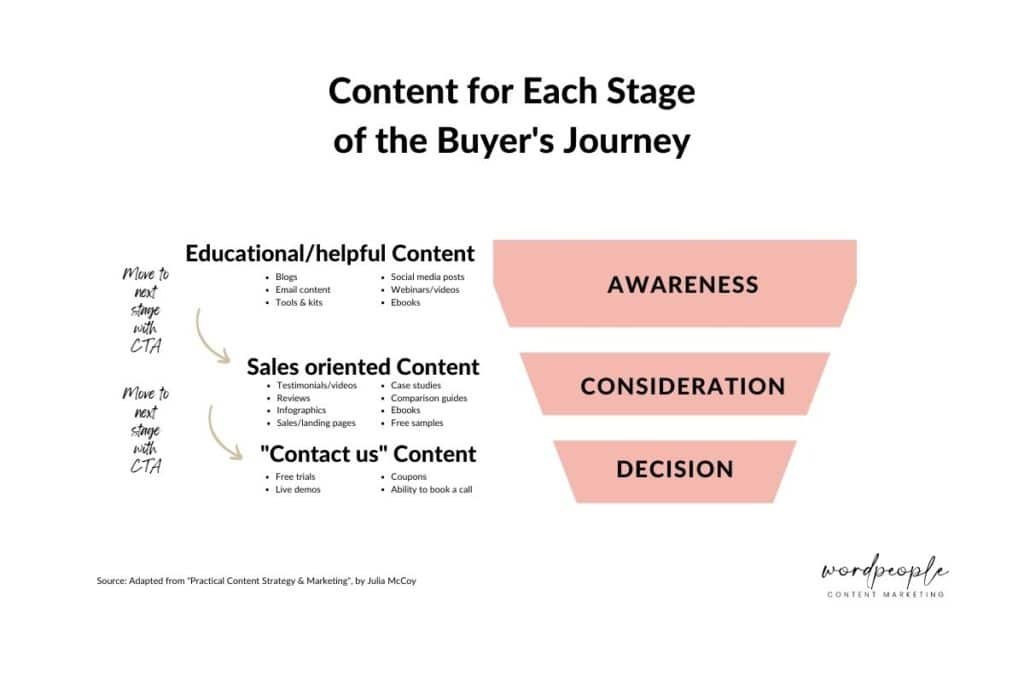
Step 4: Do your keyword research
To optimize your content from an SEO viewpoint and ensure that it will rank in a Google search, you need to do some keyword research. This will ensure you’re using the words to match what your clients are searching for. You can search for short-tail keywords (e.g. weight loss) and long-tail keywords (e.g. best workouts for weight loss).
SEO tools include:
- Semrush (expensive)
- Ubersuggest (middle range)
- Keywords Everywhere (budget)
- Answer the Public (free).
You can also dig deeper to find less competitive long-tail keywords and use them in key sections of your blog:
- Page title
- Heading tags
- Image alt text
- Body copy
- Meta title and descriptions.
Step 5: Create SEO-optimized content
Now you are ready to prepare an editorial calendar for the next 90 days or one year. I prefer planning annually because it ultimately saves me time and ensures that I cover all my content clusters and high-intent keywords. Plus, I can also see at a glance any gaps in terms of the variety in the types of content I am producing (ie. blog posts, checklists, videos, infographics).
Here is an example editorial calendar that includes channels for distribution and promotion.
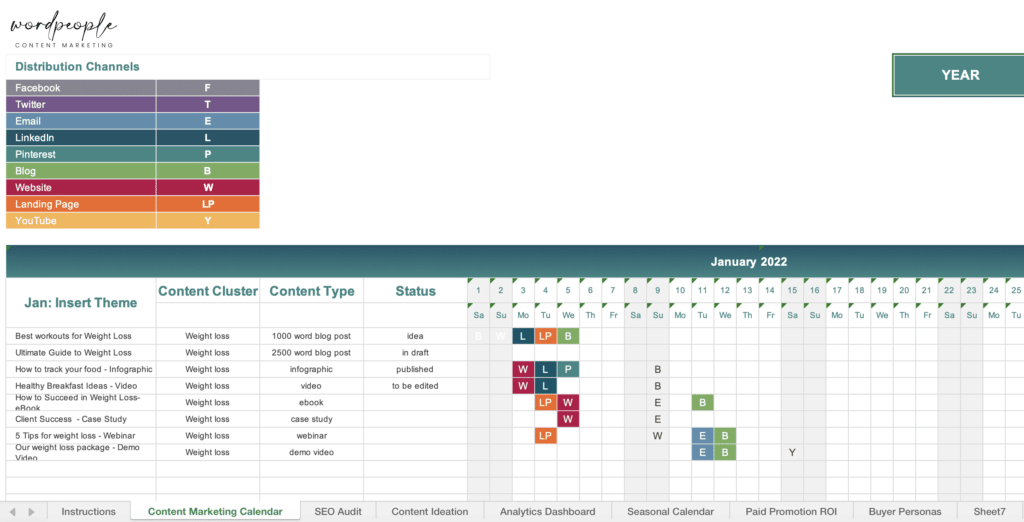
Some general tips to remember for blogging include:
- Your blog’s word length should be at least 1000 words
- Use different formats: articles, infographics, videos
- Include external links to external sites with high domain authority
- Include internal links to other parts of your site, landing page, or other blog articles.
Step 6: Distribute and promote your content
After you have created your content, you need enough time and budget to promote it in all the channels where your ideal clients hang out. You could post a blog article, share the top highlights in a weekly client email, and then make a daily key takeaway post on Instagram.
Here is a good example:

You can also reach out to other influencers in your space with whom you share an audience. They could be other bloggers, YouTubers, social media influencers, or groups in which you are a member of on Facebook or LinkedIn.
Make sure that you have Google Analytics set up to measure the performance of your content.
You can get some ideas about key social media influencers from Sparktoro which provides audience research data.
Step 7: Track the performance of your content
Measuring the effectiveness of your content can be tricky as not every single piece of content will lead directly to an increase in sales. That’s why engagement metrics are the best methods to monitor.
Google Analytics
Inside the content drilldown section of Google Analytics, you can see how pages from your website are ranked according to page views, time spent, and changes in bounce rate versus the previous time period.
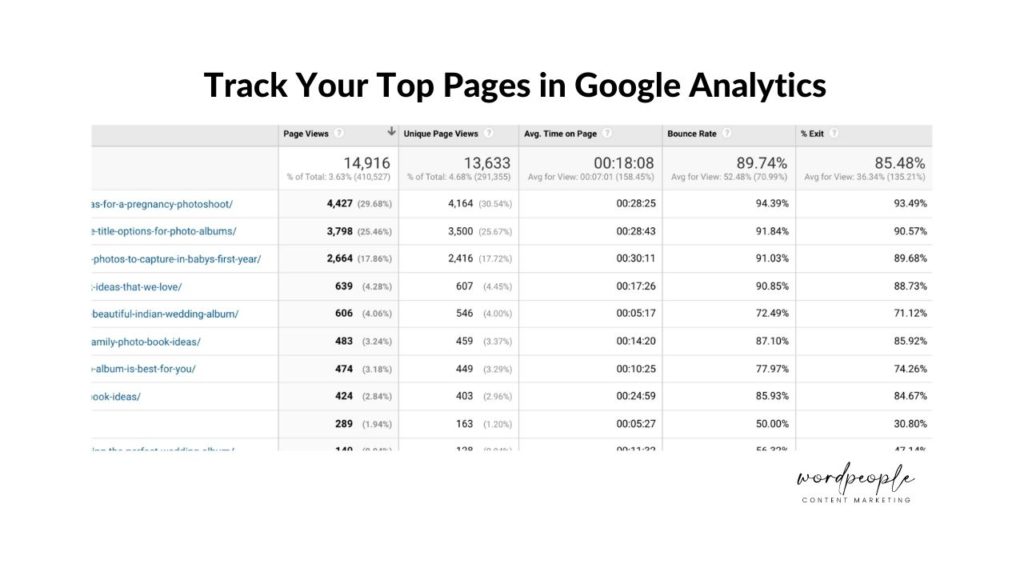
“ A three-second increase in dwell time (or how long a visitor stays on your web page) correlates with one position higher ranking in search results”, Adam Heitzman
This data should be checked weekly to identify the most popular pages with the highest read time on your website. The content with the highest engagement and lowest bounce rate can then be promoted via email, social media and be used as inspiration for future content.
“Google knows how people behave on your website and how long they stay on it before going elsewhere. The longer a visitor stays on a website, the more search engines consider the site to be relevant to the keyword phrase that brought them to the web page in the first place.” Dean Scaduto, Author of SEO Fundamentals for Small Business Owners
Email metrics
Another key metric to measure the success of your content is the growth in your email list. Your email subscription rate measures engagement because if visitors are really engaged and like your content, they will subscribe.
Here is a summary of the top metrics to track:
- Page views
- Organic search traffic
- % traffic from unbranded search
- Social traffic
- Bounce rate
- Pages/visit
- Time spent
- Social shares
- Email subscribers
- Conversions
- Google rankings
- Backlinks
Summary
Creating a content strategy will ultimately save you time and money as you will be able to able to quickly and consistently create relevant and engaging content for your ideal clients.
You might also be interested in:
- Blog post: What is a content strategy?
- Guest Blog: Attract More Clients Online: Serve First, Sell Second
- Google Analytics Account Setup & Optimization Checklist
- Take the Quiz: What type of content creator are you?
If you’re ready to jumpstart your website’s blog with regular high-quality content, see my SEO-optimized blog packages or set up a quick consultation.

Melissa Birchler
Melissa Birchler is a content specialist and experienced freelance journalist. She helps create successful content marketing programs for firms in the services sector.

